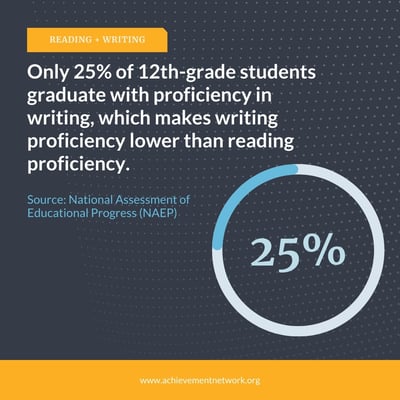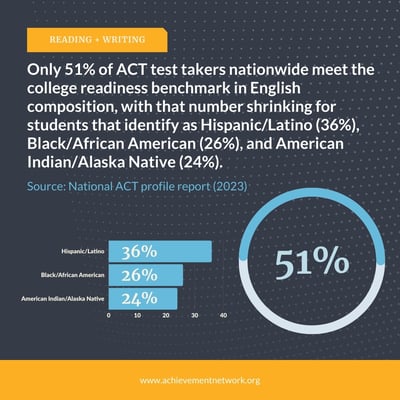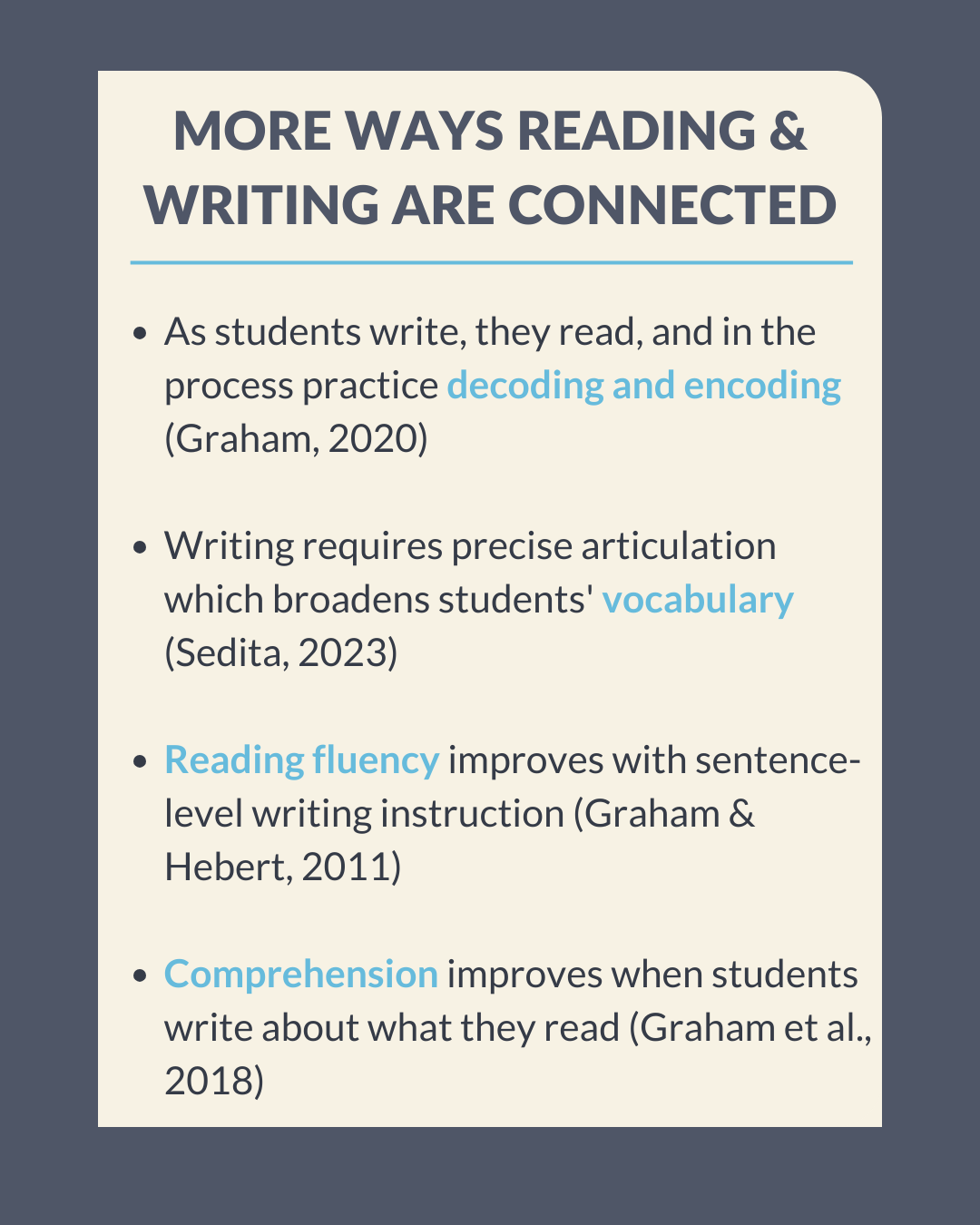The Current State of Writing
The goal of our literacy blog series at ANet is to shine a light on topics that do not often get enough attention. While our first installment focused on supporting striving older readers to thrive, we turn our attention this time to writing and the integral role it plays in building a literate identity. At ANet, one of the most common challenges we hear from the many schools and systems we partner with around literacy is, “Our students have trouble communicating their ideas in writing.” ANet partners are not alone. Similar to national reading data, writing data show that students, especially those who are members of our student populations, are insufficiently prepared for the writing demands of colleges and careers.




Despite the evidence pointing to a strong need for writing preparedness, schools often allocate disproportionate time and resources to reading instruction, leaving writing education lagging behind. Approximately a quarter of middle and high school students spend a mere 30 minutes or less on writing each day, far less than what research recommends (Picou, 2020).
To address this challenge, educators need to understand the integral role writing plays in literacy development and even more specifically, the explicit and deep connection between reading and writing.
How are reading and writing connected? 
Reading and writing share a deep and symbiotic relationship. At its core, writing represents the output of one's thoughts, while reading acts as the input, facilitating comprehension. Together, they form the cornerstone of educational development. We engage in reading to absorb knowledge, and we solidify and express that knowledge through writing.
Understanding the connections between reading and writing is crucial, as these complementary skills enhance each other in important ways. For instance, as students read, they are not only acquiring content knowledge; they are also exposed to elements of genre and structure that they can replicate. This exposure fuels their writing, enriching their own compositions by providing them with examples that serve to strengthen their organization, build their vocabulary, and find their voice as writers. Additionally, when students engage in the act of writing, they refine their reading abilities. As they attend to elements of organization, vocabulary, and voice in their own writing process, they cultivate skills that translate into more adept reading comprehension. This is because they understand the intentional choices the writer of the text made, allowing them to think more deeply and analytically about the meaning the author intended (Graham, 2020).
So what can we do?
Often, writing prompts and assignments are just handed out as if students will instinctively know how to write. The assumption is that students naturally develop writing skills through exposure to reading materials. But, this falls short of reality. Writing is a challenge for students, even those proficient in reading and oral communication (Hochman & Wexler, 2017). Just as reading requires systematic and explicit instruction, writing also demands a structured approach. The What Works Clearinghouse recommends 1 hour of writing per day with 30 minutes of this time dedicated to the explicit teaching of writing techniques and skills (2018).
The Writing Revolution
One way to cultivate proficient writers is for teachers to begin with the foundational unit of writing: the sentence. Assigning complex essays to students incapable of constructing coherent sentences only breeds frustration and undermines their confidence. By beginning at the sentence level, teachers provide learners with a manageable starting point, alleviating the anxiety of composing lengthier pieces. This approach allows students to focus their efforts on refining specific elements of their writing, such as syntax, vocabulary, and punctuation. Eventually, students will be able to place more of their cognitive load on the content of their writing (Graham & Harris, 2018).
Focusing on the sentence level also enables teachers to teach explicit writing skills systematically. The Writing Revolution (a highly effective method for writing instruction) advocates for a structured approach to writing instruction. For example, they recommend beginning with teaching students to recognize and correct fragments and run-on sentences. Equipping students with the foundation of sentence structure, including subjects, predicates, and conjunctions, empowers them to engage in writing activities that enhance their skills. Activities such as correcting lists of sentence fragments and practicing conjunctions through strategies like "Because, But, So" provide practical avenues for skill development (Hochman & Wexler, 2017).
Reading Like a Writer
There are great benefits to integrating writing instruction with reading activities, but many teachers don’t feel prepared to undertake this task (Carter, Abbott, & Wright, 2023). This is because fewer than 30% of teachers receive training in writing during their teacher preparation programs (Troia & Graham, 2016), and this lack of preparation impacts classrooms. So, what else can teachers do?
When reading in school, students are often asked to read for content. Whether finding the main idea or tracking the plot, this traditional approach, known as "reading like a reader," focuses on absorbing information to enhance learning. On the other hand, "reading like a writer" is a way to teach and strengthen writing and build comprehension (Bunn, 2011). It invites students to dig deeper into the text, scrutinizing not just what is being written, but how it is being written. By examining authors’ choices and techniques, students gain insight into the construction of the text. They must consider stylistic elements and choices, such as language use, narrative structure, and rhetorical devices. Students learn to ask themselves questions like:
- Why did the writer write this text? What was their purpose?
- Who did the author write this text for?
- What choices did the author make? About the structure? Their tone? The words they used?
By “reading like a writer,” students learn effective writing strategies. And, this not only empowers students to produce more polished and cohesive compositions but also cultivates a sense of agency and ownership over their writing. Click here for an example of what “reading like a writer” looks like with an ANet Interim passage and question.
Conclusion
Writing is an essential skill and current data show that we are not preparing our students well enough to enter colleges and careers as strong, confident writers. Some ways to improve our writing instruction include:
- Ensure students get adequate time to write every day, across content and grade levels
- Support educators to understand the inherent and important connections between reading and writing so that who students are as readers can bolster who they are as writers and vice versa
- Teach writing with intention with a focus on smaller units of writing like sentences
- Build students’ ability to read like writers in addition to reading like readers
All of our students have something important to say. It is up to us as educators to empower them with the ability to communicate and advocate for themselves using the written word by providing them with the writing instruction they deserve.
Explore more on our foundational literacy page!
Resources:
ACT Profile Report. (2023). ACT, Inc. https://www.act.org/content/dam/act/unsecured/documents/2023-National-ACT-Profile-Report.pdf
Bunn, M. (2011). How to Read Like a Writer. Parlor Press.
Carter, H., Abbott, J., & Landau Wright, K. (2022). Preservice teachers’ preparedness to teach writing: Looking closely at a semester of structured literacy tutoring. Journal of Writing Research, 14(1), 77-111, https://doi.org/10.17239/jowr-2022.14.01.03
Graham, S. (2020). The science of reading and writing must become more fully integrated. Reading Research Quarterly, 55(51), 535-544. doi:10.1002/rrq.332
Graham, S., Bollinger, A., Booth Olson, C., D’Aoust, C., MacArthur, C., McCutchen, D., & Olinghouse, N.(2012).Teaching elementary school students to be effective writers: A practice guide (NCEE 2012- 4058). Washington, DC: National Center for Education Evaluation and Regional Assistance, Institute of Education Sciences, U.S. Department of Education.
Retrieved from http://ies.ed.gov/ncee/wwc/publications_reviews.aspx#pubsearch.
Graham, S. & Harris, K.R. (2016). A path to better writing: Evidence-Based practices in the classroom. The Reading Teacher, 69(4), 359-365. doi:10.1002/trtr.1432
Graham, S., & Hebert, M. (2011). Writing to read: A meta-analysis of the impact of writing and writing instruction on reading. Harvard Educational Review, 81(4), 710–744. https://doi.org/10.17763/haer.81.4.t2k0m13756113566
Graham, S., Liu, X., Bartlett, B., Ng, C., Harris, K. R., Aitken, A., Barkel, A., Kavanaugh, C., & Talukdar, J. (2018). Reading for writing: A meta-analysis of the impact of reading interventions on writing. Review of Educational Research, 88(2), 243-284. https://doi.org/10.3102/0034654317746927
Hochman, J.C. & Wexler, N. (2017). The Writing Revolution: A Guide to Advancing Thinking Through Writing in All Subjects and Grades. Jossey-Bass.
NACE Job Outlook. (2024). National Association of Colleges and Employers. https://www.naceweb.org/docs/default-source/default-document-library/2023/publication/research-report/2024-nace-job-outlook.pdf?sfvrsn=57be133e_5
Picou, A. (2020). Are schools making writing a priority: New study shows students do not spend enough time writing. The Learning Agency Lab. Link to the PDF
Authors


